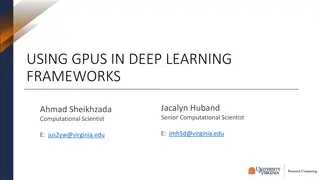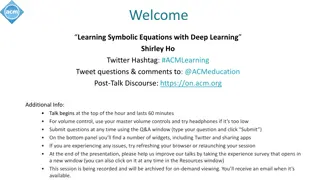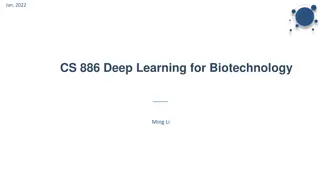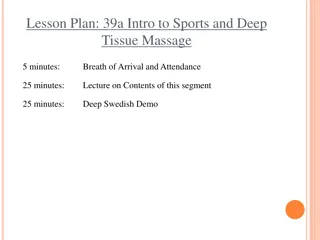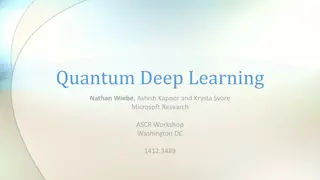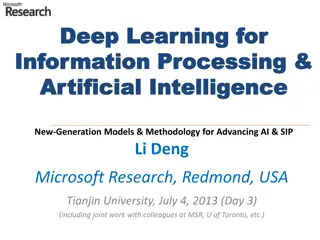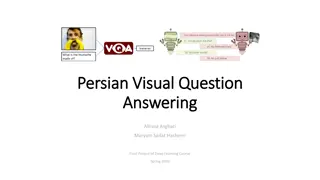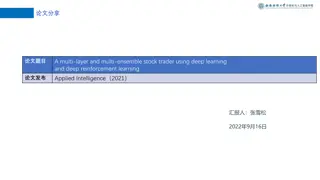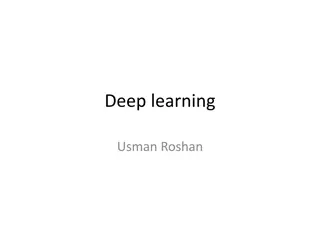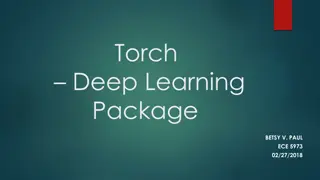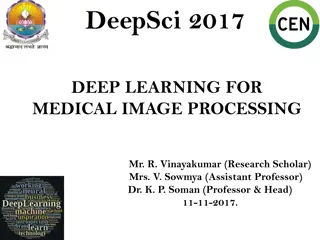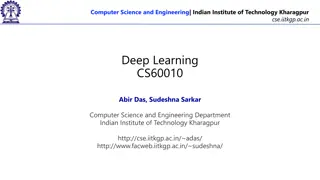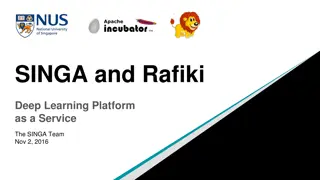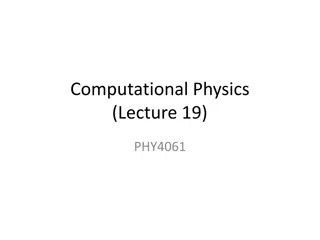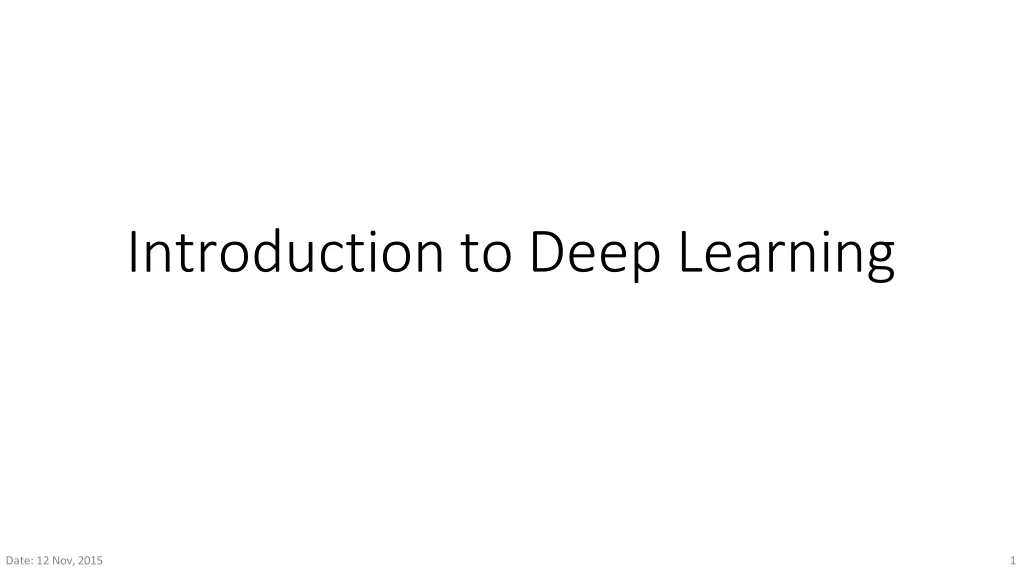
Unveiling the Depths of Deep Learning
Dive into the world of deep learning, where algorithms aim to understand scenes and interact with humans using natural language concepts. Explore the challenges in modeling complex behaviors and learn how deep architectures are trained, drawing inspiration from the mammalian brain.
Download Presentation

Please find below an Image/Link to download the presentation.
The content on the website is provided AS IS for your information and personal use only. It may not be sold, licensed, or shared on other websites without obtaining consent from the author. If you encounter any issues during the download, it is possible that the publisher has removed the file from their server.
You are allowed to download the files provided on this website for personal or commercial use, subject to the condition that they are used lawfully. All files are the property of their respective owners.
The content on the website is provided AS IS for your information and personal use only. It may not be sold, licensed, or shared on other websites without obtaining consent from the author.
E N D
Presentation Transcript
Introduction to Deep Learning Date: 12 Nov, 2015 1
A Motivational Task: Percepts Concepts Create algorithms that can understand scenes and describe them in natural language that can infer semantic concepts to allow machines to interact with humans using these concepts Requires creating a series of abstractions Image (Pixel Intensities) Objects in Image Object Interactions Scene Description Deep learning aims to automatically learn these abstractions with little supervision Courtesy: Yoshua Bengio, Learning Deep Architectures for AI 2
Deep Visual-Semantic Alignments for Generating Image Descriptions (Karpathy, Fei-Fei; CVPR 2015) "boy is doing backflip on wakeboard." two young girls are playing with lego toy. "man in black shirt is playing guitar." "construction worker in orange safety vest is working on road." http://cs.stanford.edu/people/karpathy/deepimagesent/ 3
Challenge in Modelling Complex Behaviour Too many concepts to learn Too many object categories Too many ways of interaction between objects categories Behaviour is a highly varying function underlying factors f: L V L: latent factors of variation low dimensional latent factor space V: visible behaviour high dimensional observable space f: highly non-linear function 4
Example: Learning the Configuration Space of a Robotic Arm 5
How do We Train Deep Architectures? Inspiration from mammal brain Multiple Layers of neurons (Rumelhart et al 1986) Train each layer to compose the representations of the previous layer to learn a higher level abstraction Ex: Pixels Edges Contours Object parts Object categories Local Features Global Features Train the layers one-by-one (Hinton et al 2006) Greedy strategy 7
Multilayer Perceptron with Back-propagation First deep learning model (Rumelhart, Hinton, Williams 1986) Compare outputs with correct answer to get error signal Back-propagate error signal to get derivatives for learning outputs hidden layers input vector Source: Hinton s 2009 tutorial on Deep Belief Networks 8
Drawbacks of Back-propagation based Deep Neural Networks They are discriminative models Get all the information from the labels And the labels don t give so much of information Need a substantial amount of labeled data Gradient descent with random initialization leads to poor local minima
Hand-written digit recognition Classification of MNIST hand-written digits 10 digit classes Input image: 28x28 gray scale 784 dimensional input
A Deeper Look at the Problem One hidden layer with 500 neurons => 784 * 500 + 500 * 10 0.4 million weights Fitting a model that best explains the training data is an optimization problem in a 0.4 million dimensional space It s almost impossible for Gradient descent with random initialization to arrive at the global optimum
A Solution Deep Belief Networks (Hinton et al. 2006) Pre-trained N/W Weights Slow Fine-tuning (Using Back-propagation) Fast unsupervised pre-training Good Solution Random Initial position Very slow Back-propagation (Often gets stuck at poor local minima) Very high-dimensional parameter space
A Solution Deep Belief Networks (Hinton et al. 2006) Before applying back-propagation, pre-train the network as a series of generative models Use the weights of the pre-trained network as the initial point for the traditional back-propagation This leads to quicker convergence to a good solution Pre-training is fast; fine-tuning can be slow
Quick Check: MLP vs DBN on MNIST MLP (1 Hidden Layer) 1 hour: 2.18% 14 hours: 1.65% DBN 1 hour: 1.65% 14 hours: 1.10% 21 hours: 0.97% Intel QuadCore 2.83GHz, 4GB RAM MLP: Python :: DBN: Matlab
Intermediate Representations in Brain Disentanglement of factors of variation underlying the data Distributed Representations Activation of each neuron is a function of multiple features of the previous layer Feature combinations of different neurons are not necessarily mutually exclusive Localized Representation Sparse Representations Only 1-4% neurons are active at a time Distributed Representation 15
Local vs. Distributed in Input Space Local Methods Assume smoothness prior g(x) = f(g(x1), g(x2), , g(xk)) {x1, x2, , xk} are neighbours of x Require a metric space A notion of distance or similarity in the input space Fail when the target function is highly varying Examples Nearest Neighbour methods Kernel methods with a Gaussian kernel Distributed Methods No assumption of smoothness No need for a notion of similarity Ex: Neural networks 16
Multi-task Learning Source: https://en.wikipedia.org/wiki/Multi-task_learning 17
Desiderata for Learning AI Ability to learn complex, highly-varying functions Ability to learn multiple levels of abstraction with little human input Ability to learn from a very large set of examples Training time linear in the number of examples Ability to learn from mostly unlabeled data Unsupervised and semi-supervised Multi-task learning Sharing of representations across tasks Fast predictions 18

